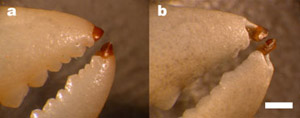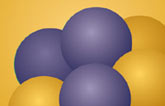

Friday - June 5, 2009
SLAC Today is
available online at:
http://today.slac.stanford.edu
In this issue:
Bromine-rich Tips of Calcified Crab Claws as Model for Biomaterials
Word of the Week: Baryon
 |
 |
|
Friday - June 5, 2009 |
Bromine-rich Tips of Calcified Crab Claws as Model for Biomaterials The darker material at the tip of the shore crab claws
is heavy element biomaterial. Figures a and b show the same claw before
and after bead blasting. In b, claw tips are less eroded than surrounding calcified material. Scale bar: 2 mm.
The tips of crab pincers are made of a very hard material, allowing crabs to fight and forage without wearing down their tools. Made mostly of proteins, the claw tip is known to be bromine-rich instead of calcium-rich like the surrounding area, but the biochemical structure and mechanical properties were mostly unknown. Understanding this hard material could lead to development of materials ideal for creating small, fracture-resistant tools. A team led by Robert Schofield of the University of Oregon and Robert Scott of the University of Georgia in Athens found that the uncalcified, bromine-rich material is harder and stiffer than normal arthropod cuticle that lacks heavy elements, and much more resistant to fracture than the calcified material in other parts of the crab. Theorizing that the resistance to fracture comes from the arrangement of bromine atoms in the protein structure, the team collaborated with Stanford Synchrotron Radiation Lightsource scientist Matthew Latimer to analyze the distribution and environment of bromine atoms in the crab claw tip. Using X-ray microscopy and spectroscopy at SSRL Beamline 9-3, they found the bromine is evenly dispersed and likely bonds to phenyl rings, suggesting that a bromotyrosine moiety may be central to the special properties of this material. The researchers propose two possible explanations. The bromine could stiffen the material by creating more cross-links between the protein residues. Alternately, the presence of the heavy atoms could dampen energies created in impacts through their high electron densities. The results are published in the June issue of the Journal of Structural Biology. To learn more about this research, see the full scientific highlight.  Word of the Week: BaryonBaryons are gluon-bound clusters of fundamental particles called quarks. Three quarks to be exact, each being one of three different "colors:" red, green or blue. Baryons come in many forms, the most famous among their ranks being the protons and neutrons found at the core of atoms. These familiar constituents are by far the most stable of the baryons, most others having fleeting existences that make them detectable only amidst the fallout of high-energy particle collisions. Sister to the baryons are the mesons, particles composed of a quark and a corresponding anti-quark. Together, baryons and mesons are classified as hadrons—an umbrella term used to describe all particles made of quarks. |
Events
Access (see all)
Announcements
|
|
| | ||
|
|
||
 <%
Response.AddHeader "Last-modified", getArticleDate()
'Response.AddHeader "Last-modified","Mon, 01 Sep 1997 01:03:33 GMT"
'Monday, December 06, 2010
%>
<%
Response.AddHeader "Last-modified", getArticleDate()
'Response.AddHeader "Last-modified","Mon, 01 Sep 1997 01:03:33 GMT"
'Monday, December 06, 2010
%>View online at http://today.slac.stanford.edu/. |
||